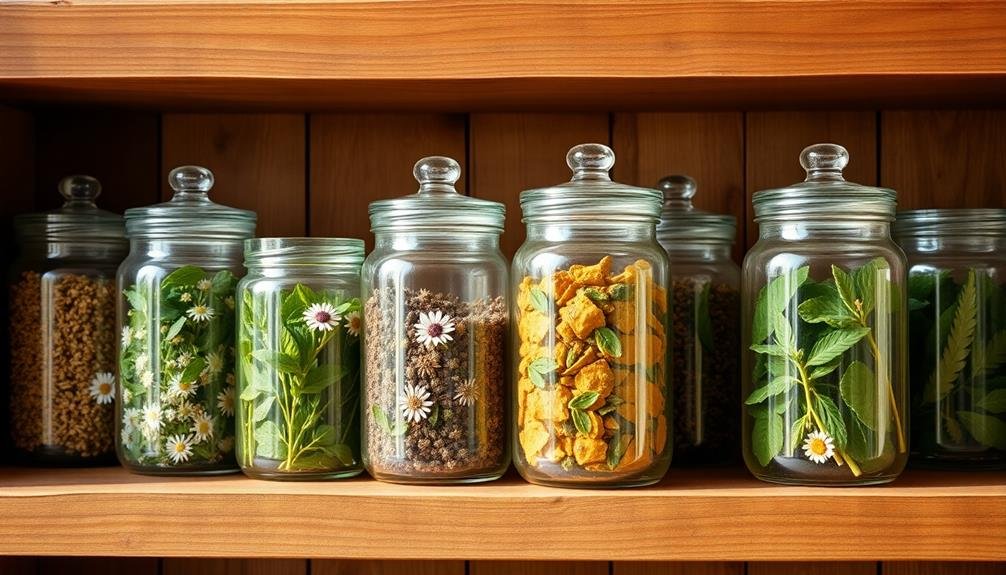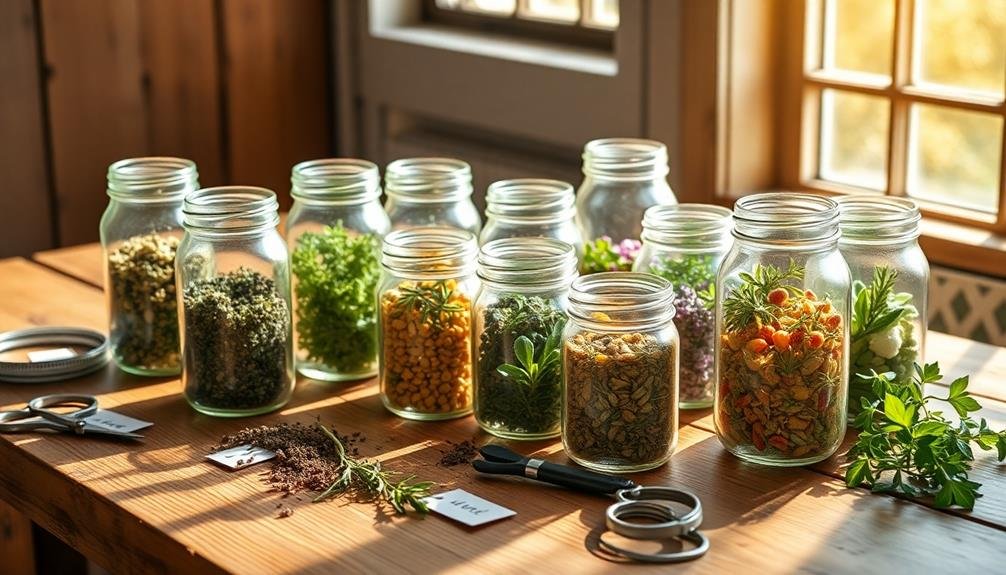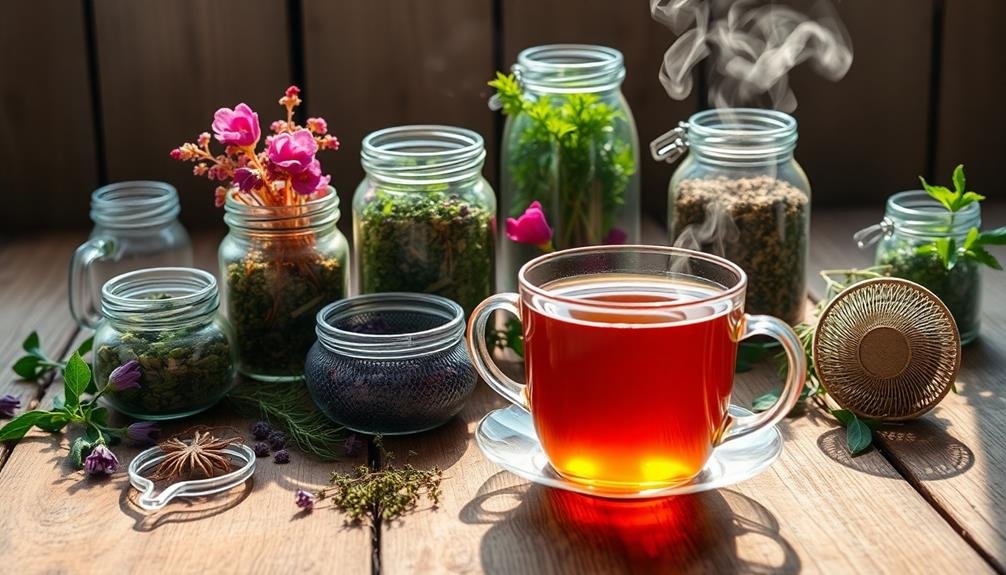To preserve dried herbs for long-lasting tea blends, start by selecting flavorful options like peppermint and chamomile. Use proper drying methods such as air drying, oven drying, or a dehydrator to guarantee your herbs are completely dry. Store them in airtight containers, like glass jars or opaque metal tins, in cool, dark places. Avoid heat and moisture, and label each jar with the herb name and date. Keep an eye on humidity levels to prevent spoilage, and remember to discard any herbs showing signs of mold. You'll discover even more tips for ideal preservation ahead.
Choosing the Right Herbs

When you're selecting herbs for your tea blends, it's essential to take into account both flavor and health benefits. Start by contemplating the taste profile you want to achieve. For a invigorating blend, you might choose peppermint or chamomile. If you're looking for something more earthy, think about incorporating rooibos or hibiscus. Each herb contributes a unique flavor, so experiment to find combinations that excite your palate.
Next, don't overlook the health benefits associated with different herbs. For instance, ginger can aid digestion, while lemon balm is known for its calming effects. Research the properties of each herb to tailor your blend not only for taste but also for wellness.
It's also wise to reflect on the balance of flavors. Combining stronger herbs with milder ones can create a harmonious blend. For example, mixing robust flavors like sage with delicate notes of lavender can yield a well-rounded tea.
Drying Methods for Herbs
Drying herbs properly is essential to preserving their flavor and aroma for your tea blends. There are several effective methods you can use to dry your herbs, each with its own benefits.
Air drying is one of the simplest methods. Just tie the herbs into small bundles and hang them upside down in a cool, dark, and well-ventilated area. This method allows moisture to escape while retaining the essential oils that contribute to flavor.
If you prefer a quicker option, consider using an oven. Set the temperature to the lowest setting, spread the herbs in a single layer on a baking sheet, and keep the door slightly ajar. Check them frequently to prevent burning.
A food dehydrator is another excellent choice. It provides controlled heat and airflow, guaranteeing even drying and preserving the herbs' potency.
Finally, you can also use a microwave for a rapid approach. Place the herbs between two paper towels and microwave in short bursts, checking constantly until they're dry.
Whichever method you choose, make certain the herbs are completely dry before storing them to prevent mold and spoilage in your future tea blends.
Essential Storage Containers

Choosing the right storage containers is essential for maintaining the quality of your dried herbs. You want to guarantee that they stay fresh, potent, and flavorful for your tea blends.
Opt for airtight containers made of glass, metal, or high-quality plastic. Glass jars with tight-sealing lids are popular because they're non-reactive and easy to clean. If you're using metal, choose opaque options that block light, which can degrade your herbs over time.
Avoid clear plastic containers, as they allow light to penetrate, leading to a loss of flavor and potency. Whatever material you select, confirm it's food-safe and durable.
Consider the size of your containers, too. You don't want to pack them too tightly, as this can crush your herbs and release essential oils that contribute to their flavor. Instead, choose containers that fit your storage needs without cramming them in.
Label each container with the herb's name and the date you dried it. This helps you keep track of freshness and guarantees you're using your herbs at their peak potency.
Best Storage Conditions
Maintaining the integrity of your dried herbs requires careful attention to their storage conditions. To guarantee they retain their flavors and beneficial properties, keep them in a cool, dark place. Exposure to heat, light, and moisture can quickly degrade their quality. A pantry or cupboard works well, as long as it's away from the stove or any direct sunlight.
You should also be mindful of humidity. High humidity can lead to mold growth, so it's essential to keep your herbs dry. If you live in a particularly humid area, consider using silica gel packets in your storage containers to absorb excess moisture.
Temperature is another critical factor. Aim for a consistent environment, ideally between 60°F and 70°F (15°C to 21°C). Fluctuations in temperature can cause condensation inside containers, leading to spoilage.
Tips for Long-Term Freshness

To keep your dried herbs fresh over the long haul, consider using airtight containers. Glass jars with tight-fitting lids or vacuum-sealed bags work best. These containers prevent moisture and air from spoiling your herbs.
Make sure to store them in a cool, dark place, away from heat sources and direct sunlight, as light and heat can degrade flavors and potency.
Label each container with the herb's name and the date you dried it. This way, you can keep track of freshness and use older herbs first. When handling your herbs, always use clean, dry utensils to avoid introducing moisture.
If you notice any signs of mold or unusual smells, it's best to discard those herbs. For added longevity, consider freezing herbs in ice cube trays filled with water or oil. This method preserves flavor and makes it easy to add a burst of herbal goodness to your tea blends.
Lastly, remember that while dried herbs last longer than fresh ones, they still lose potency over time. Aim to use them within a year for the best flavor.
Regularly check your stash and replenish as needed to keep your tea blends vibrant and delicious.
Frequently Asked Questions
How Can I Tell if My Dried Herbs Are Still Fresh?
To tell if your dried herbs are still fresh, crush a few leaves and smell them. If the aroma's weak or they feel brittle, they've likely lost their potency and aren't fresh anymore.
Can I Mix Different Herbs in One Storage Container?
Yes, you can mix different herbs in one storage container, but make sure they have similar moisture levels and flavors. Doing so helps create unique blends, but be cautious to avoid overpowering combinations.
What's the Best Way to Grind Dried Herbs for Tea?
To grind dried herbs for tea, use a mortar and pestle or a spice grinder. Start with small amounts, pulse gently, and sift to achieve your desired consistency. Freshly ground herbs enhance flavor and aroma considerably.
Are There Any Herbs That Shouldn't Be Dried?
Some herbs, like basil and parsley, lose their flavor and aroma when dried. You'll find fresh versions retain more potency for culinary use. Always consider freshness to guarantee you're getting the best taste in your dishes.
How Long Can I Store Dried Herbs Before They Lose Potency?
You can typically store dried herbs for about one to three years before they start losing potency. Keep them in a cool, dark place, and always check for freshness before using them in your blends.
In Summary
By choosing the right herbs and drying them properly, you can create delightful tea blends that last. Remember to store your dried herbs in essential containers to protect them from light, air, and moisture. Keep them in a cool, dark place for the best results. With these simple tips, you can enjoy the vibrant flavors and aromas of your dried herbs for months to come. So go ahead, brew that perfect cup of tea anytime!





Leave a Reply